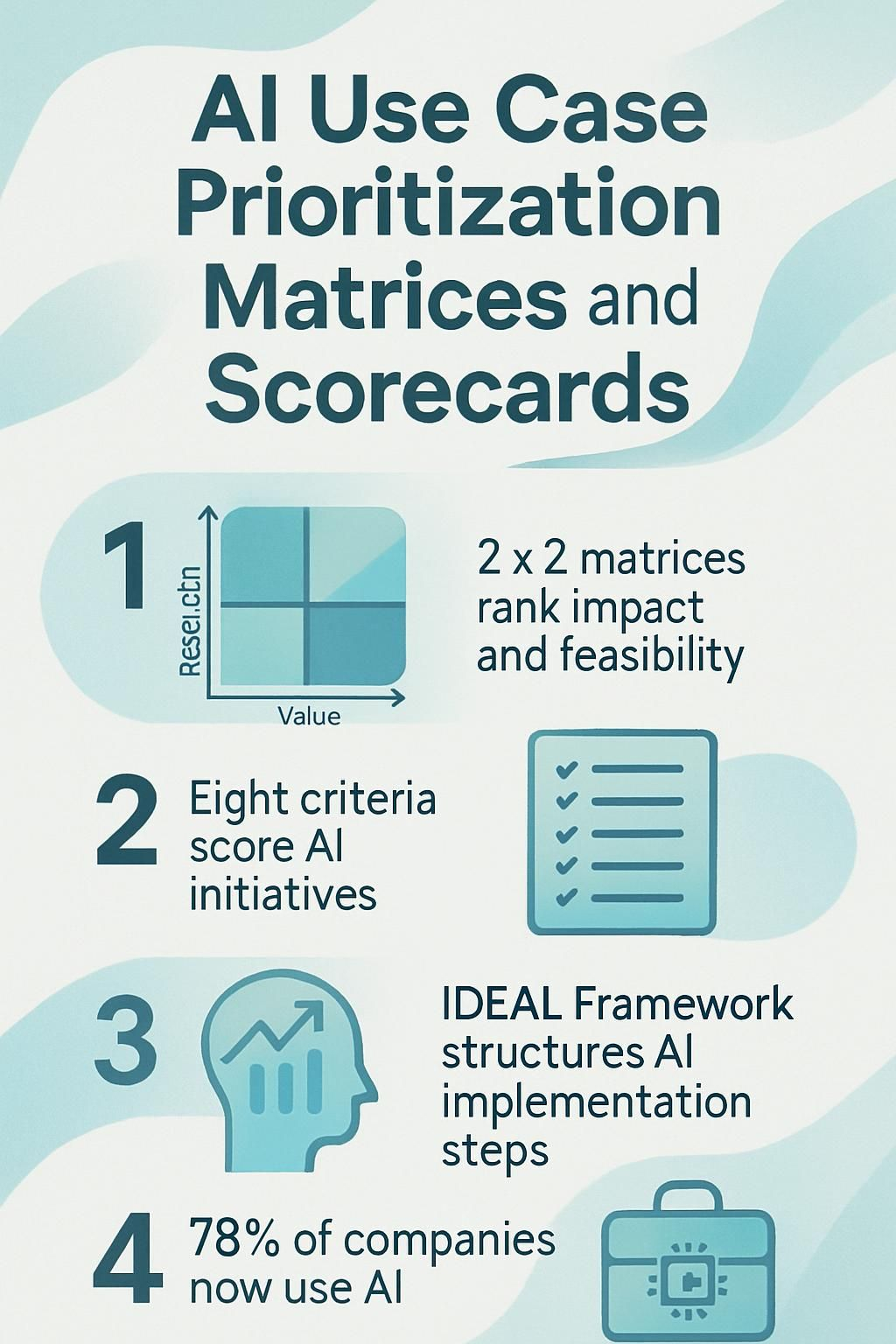AI Use Case Prioritization Matrices and Scorecards


Understanding AI Integration
AI use case prioritization matrices and scorecards help businesses sort through countless AI opportunities to find the ones worth pursuing. Recent data shows 78% of organizations used AI in at least one function in 2024, up from 55% in 2023.
This rapid growth creates a problem: too many AI possibilities and not enough resources to tackle them all. Many companies jump at shiny new AI tools without a clear plan, wasting time and money on projects that deliver little value.
I'm Reuben "Reu" Smith, founder of WorkflowGuide.com, where I've helped generate $200M for partners through smart automation strategies. After building over 750 workflows and watching countless businesses struggle with AI implementation, I've learned that success starts with proper prioritization.
At WorkflowGuide.com, we transform AI‑curious organizations into AI‑confident leaders with practical, business‑first strategies. Our approach emphasizes solving real problems before deploying technology, building trust through ethical practices, and enabling teams to achieve measurable ROI through effective project prioritization.
Think of AI prioritization like sorting your inventory in a video game. You can't carry everything, so you must decide what items give you the best chance to win. The most common approach uses a 2x2 matrix that plots potential AI projects based on business impact and technical feasibility.
Projects then fall into simple categories: Green Light (high value, easy to do), Proceed with Caution (worth considering), or Stop! (not worth the effort).
Beyond basic matrices, companies use detailed scorecards with eight typical criteria: alignment with business goals, expected value, data availability, difficulty to operationalize, scalability, risk factors, competitive advantage, and stakeholder support.
Frameworks like IDEAL, BXT, and GSAIF provide structured paths to evaluate options without requiring confidential information.
Real‑world success stories prove the value of careful prioritization. Ulta Beauty boosted sales through personalized marketing. SPAR ICS achieved over 90% accuracy in inventory prediction. Levi Strauss improved demand forecasting. Healthcare organizations saved lives with predictive analytics. Manufacturing companies stand to gain up to $2.6 trillion by 2025 through smart AI adoption.
This article will walk you through practical steps to build your own AI prioritization system. Let's start sorting your AI options so you can stop wasting resources and start seeing results.
Key Takeaways
- Effective AI prioritization prevents wasting resources on flashy projects with no business value, using 2x2 matrices to rank opportunities by impact and feasibility.
- Eight key criteria help score AI initiatives, including business alignment, data availability, and expected value, categorizing them as GREEN LIGHT, PROCEED WITH CAUTION, or STOP!
- Data quality issues plague about 80% of AI initiatives, making accurate assessment nearly impossible and causing many projects to fail.
- The IDEAL Framework provides a structured approach: Identify use cases, check data, pick models, build infrastructure, and create user experiences.
- Organizations that balance quick wins with long‑term goals see better results, with 78% of companies now using AI in at least one function, up from 55% last year.
Summary of Key Concepts:
- Use case evaluation
- Project prioritization
- Impact assessment
- Feasibility analysis
- Strategic analysis
- ROI analysis

Understanding AI Use Case Prioritization

AI use case prioritization helps companies avoid the "shiny object syndrome" that plagues many tech initiatives. Without proper ranking methods, teams waste resources on AI projects that look cool but deliver minimal business value.
Importance of Prioritization in AI Strategy
AI prioritization acts like a GPS for your business journey. Without it, you'll waste resources on shiny but pointless projects while missing the golden opportunities right in front of you.
In a landscape where 78% of organizations now use AI in at least one function (up from 55% last year), random implementation just doesn't cut it anymore. Your competitors are getting smarter about their AI choices.
The difference between successful AI adoption and expensive tech failures often comes down to one thing: ruthless prioritization.
Think of AI use case prioritization as your business reality check. The 2x2 matrix approach sorts potential projects by impact and feasibility, preventing you from chasing AI unicorns with no practical value.
Eight key criteria, including business alignment and data availability, help score each initiative into simple categories: GREEN LIGHT (full speed ahead), PROCEED WITH CAUTION (needs work), or STOP! (abandon ship).
This structured approach transforms gut feelings into strategic decisions that actually move the needle on your business goals.
Key Factors in AI Strategy:
- Project prioritization using a decisionmaking matrix
- Use case evaluation based on impact and feasibility
- Alignment with business goals through clear scoring criteria
Common Pain Points in Use Case Selection
Many businesses stumble when picking AI use cases because they treat each case like an island. This isolation creates a fragmented approach that wastes resources and leads to poor outcomes.
I've seen tech leaders burn through budgets on flashy AI projects that never connect to actual business goals. Data quality issues plague about 80% of the AI initiatives I review, making accurate assessment nearly impossible.
You can't build a smart system on garbage data, just like you can't build a mansion on quicksand.
Resource constraints hit particularly hard for local businesses trying to compete with AI‑powered giants. The technical complexity of algorithms often scares away teams who lack specialized talent.
One client described it as "trying to solve a Rubik's cube while blindfolded." Strategic misalignment remains the silent killer of AI projects, with business goals and technical implementation speaking completely different languages.
Without a solid prioritization framework, companies risk pouring money into projects that look cool but deliver zero value. The most successful AI implementations start with crystal‑clear business problems, not shiny tech solutions.
Summary of Common Pain Points:
- Fragmented approach to use case evaluation
- Poor data quality impacting decisionmaking tools
- Misalignment between business goals and technical feasibility
- Risk of investing in low‑value AI projects
Frameworks for Identifying AI Use Cases
Finding the right AI use cases requires a structured approach that maps your business problems to specific AI capabilities. Frameworks like the GSAIF help businesses cut through the noise and identify opportunities where AI can deliver actual value instead of just looking cool on a PowerPoint slide.
Defining Business Challenges and Objectives
Before considering AI solutions, prudent business leaders should clearly define their actual problems. Many companies have invested in sophisticated AI tools that remain unused because they addressed non‑existent issues.
Begin by assembling your team to identify specific pain points that impact your bottom line. Ask direct questions such as "What tasks consume most of our time?" or "Where do we lose customers?" Document these challenges with concrete numbers.
For example, "Our customer service team spends 40% of their time answering basic questions" provides a tangible target for improvement.
Your objectives should directly connect to these challenges and align with your broader business strategy. The most effective AI projects address problems where success can be measured.
Eight key criteria exist for evaluating AI use cases, with business alignment ranking as one of the most critical factors. Projects with high strategic necessity might deserve priority even when technical feasibility seems low.
Stakeholder support plays a crucial role in this process, as it ensures your AI initiatives address genuine business challenges rather than exciting tech distractions.
The right AI solution doesn't begin with technology, it begins with a clearly defined business problem worth solving.
After mapping out your challenges and objectives, you'll need frameworks to identify which AI use cases are most appropriate for your situation.
Mapping AI Capabilities to Business Goals
Matching AI tools to business needs works like finding the right puzzle piece. Many companies buy fancy AI systems but fail to connect them to actual business problems. Smart leaders start with their goals first, then pick AI that fits.
The IDEAL Framework gives you a roadmap: Identify your use case, check your data, pick your model, build infrastructure, and create the user experience. This approach prevents the classic "solution looking for a problem" trap that wastes so much money in tech.
Business alignment must drive every AI decision you make. Our work with clients shows eight key criteria matter most when linking AI to goals, including clear business objectives and expected value measurement.
The BXT Framework helps balance what's good for business, what users want, and what's technically possible. For local business owners, this means you don't need the fanciest AI, just the right one for your specific challenges.
Think of AI like hiring a new employee, you wouldn't hire someone with skills you don't need, no matter how impressive their resume looks.
Discovering High‑Impact Use Cases
Finding AI use cases that pack a real punch requires detective work. Tech leaders must look beyond flashy AI capabilities and focus on actual business problems begging for solutions.
Our 2x2 matrix helps spot these golden opportunities by plotting feasibility against potential impact. The matrix creates clear categories: "Green Light" projects offer high impact with reasonable effort, while "Proceed with Caution" signals either technical challenges or modest returns.
Recent data shows 78% of organizations now use AI in at least one function, up from 55% last year, proving the hunt for valuable use cases is intensifying.
Smart discovery starts with cross‑functional workshops where IT folks and business units brainstorm together. Map current pain points against the eight scoring criteria, including business alignment and expected value.
This approach helps avoid the classic trap of "solution in search of a problem" syndrome. I once worked with a manufacturing client who ignored our framework and built an AI inventory system nobody wanted.
Six months and $200,000 later, they came back ready to follow the scorecard approach. The AI Idea Scorecard Tool offers a structured way to evaluate each potential use case before you commit resources to projects that might face external roadblocks despite their apparent value.
Want To Be In The Inner AI Circle?
We deliver great actionable content in bite sized chunks to your email. No Flim Flam just great content.

Prioritizing AI Use Cases with Matrices and Scorecards
Matrices and scorecards transform AI use case selection from a gut feeling into a data‑driven decision process. These tools help you rank potential projects based on clear metrics like ROI, technical feasibility, and strategic alignment—saving you from the classic "shiny object syndrome" that plagues many AI initiatives.
Overview of Prioritization Matrices
Prioritization matrices give business leaders a visual roadmap for AI investment decisions. The classic 2x2 matrix plots potential AI use cases on two critical axes: impact and feasibility.
This simple but powerful tool transforms complex decisions into clear visual categories, helping teams quickly spot which projects deserve green lights versus those needing caution flags.
At WorkflowGuide.com, we've seen countless tech initiatives fail because teams jumped at exciting AI capabilities without first mapping them against business goals.
The matrix approach cuts through the noise by forcing teams to score each use case across eight key criteria. These include alignment with business objectives, expected value, data availability, and scalability.
McKinsey's 2024 survey reveals this structured approach works, with 78% of organizations now successfully implementing AI in at least one function, up from 55% in 2023. For local business owners, this means you don't need enterprise‑level resources to make smart AI decisions.
You just need the right framework to evaluate which AI opportunities will actually move your business forward rather than create expensive distractions.
Key Metrics for Evaluation (e.g., ROI, Feasibility, Impact)
Choosing the right AI projects can make or break your business strategy. Let's explore the key metrics that will help you evaluate and prioritize AI use cases with confidence.
- Return on Investment (ROI): Calculate financial returns using traditional formulas or specialized frameworks like the Emerj Trinity Model. Your AI projects must meet specific hurdle rates to gain approval.
- Technical Feasibility: Assess if your organization has the right technology stack, data infrastructure, and technical talent to implement the AI solution successfully.
- Business Impact: Measure how the AI solution will affect core business metrics like revenue growth, cost reduction, customer satisfaction, or operational efficiency.
- Data Readiness: Evaluate the quality, quantity, and accessibility of data needed for your AI model to function properly.
- Implementation Timeline: Consider how quickly you can deploy the solution and start seeing results. Faster implementations often get priority.
- Risk Assessment: Identify potential pitfalls including regulatory compliance issues, data privacy concerns, and ethical considerations.
- Strategic Alignment: Rate how well the AI use case supports your company's broader business goals and digital transformation roadmap.
- Resource Requirements: Calculate the people, budget, and time needed to build, deploy, and maintain the AI solution.
- Scalability Potential: Judge if the solution can grow with your business needs or apply to multiple departments or functions.
- Competitive Advantage: Determine if the AI solution will give you an edge over competitors or simply help you catch up to industry standards.
- Organizational Readiness: Gauge your team's ability to adapt to new AI‑driven processes and workflows.
- Performance Metrics: Define clear KPIs that will track the success of your AI implementation across financial, operational, customer, and workforce dimensions.
- Cost‑Benefit Analysis: Compare direct and indirect costs against expected benefits over the short and long term.
- Data Security Implications: Assess potential vulnerabilities and security requirements for handling sensitive information.
- Maintenance Needs: Factor in ongoing support, updates, and model retraining requirements after initial deployment.
Introduction to Scorecards for Structured Decision‑Making
Scorecards transform AI decision‑making from gut feelings to data‑driven choices. They work like your favorite RPG character sheet, tracking critical stats that matter for success.
For tech leaders juggling limited resources, these structured tools create a common language between technical teams and business stakeholders. A well‑designed AI scorecard includes business feasibility metrics, risk assessment factors, data quality evaluations, and human oversight components.
This framework helps you avoid the classic "shiny object syndrome" where teams chase exciting AI applications without clear business alignment.
The beauty of scorecards lies in their transparency and communication power. They cut through technical jargon and present clear metrics everyone understands. Business leaders can quickly grasp why one AI project ranks higher than another.
The Gen AI scorecard specifically helps startups integrate artificial intelligence while staying true to business goals. Pilot testing these evaluation frameworks on small projects identifies flaws early and reduces wasted resources.
Your scorecard should evolve through feedback loops, becoming more refined with each project evaluation. This assessment approach creates accountability in AI innovation while making complex technical decisions accessible to everyone involved in the process.
Building an Effective AI Use Case Prioritization Framework
Building an effective AI use case prioritization framework starts with a clear method to sort through the noise and find gold—like that time I tried to organize my garage and discovered three perfectly good hammers I'd forgotten about.
Your framework should rank projects based on business impact, technical feasibility, and resource requirements, helping you avoid the "shiny object syndrome" that plagues many AI initiatives.
Want to stop wasting resources on AI projects that look cool but deliver zilch? Keep reading for our step‑by‑step approach that has saved companies millions in misguided tech investments.
Step 1: Identify Business Problems and Opportunities
Finding the right business problems to solve marks the critical first step in AI prioritization. Like that e‑commerce business that pinpointed five growth blockers, you need to spot your pain points before throwing AI at them.
Low customer retention and poor service efficiency aren't just buzzwords; they represent real dollars walking out your digital door. Our team at WorkflowGuide.com calls this the "problem before solution" approach.
Many companies rush to implement shiny AI tools without mapping them to actual business needs, which explains why 50% of firms lack clear AI strategy according to Harvard Business Review's 2024 report.
Start by gathering your cross‑functional stakeholders for honest discussions about operational bottlenecks. Ask pointed questions: Where do your teams waste the most time? Which customer complaints keep repeating? What growth opportunities remain untapped due to resource constraints? Document these challenges clearly, as they'll form the foundation for your AI use case evaluation.
The alignment between these identified problems and your broader business objectives will become a key criterion in the next step of our prioritization framework.
Step 2: Brainstorm Potential AI Solutions
Once you've pinpointed your business challenges, it's time to let your imagination run wild with AI possibilities. Our e‑commerce client discovered this firsthand during their workshop where we identified five key challenges before generating potential AI fixes.
We landed on three promising solutions: a personalized recommendation engine, AI chatbots for customer service, and automated content generation for product descriptions. The trick isn't just listing cool tech, but matching solutions to actual business problems.
Grab your sticky notes and gather stakeholders from different departments for this brainstorming phase. Marketing folks might spot personalization opportunities while operations teams focus on efficiency gains.
In our client's case, cross‑team collaboration proved vital for evaluation criteria development. Don't worry about feasibility yet; this stage welcomes all ideas regardless of how wild they seem.
Just make sure each potential solution connects directly to a business objective from step one. The IDEAL Framework helps structure this process: Identify Use Case, Determine Data needs, Establish Model requirements, Architect Infrastructure, and plan the Launch Experience.
Step 3: Assess Feasibility and Business Value
Assessing feasibility and business value acts like your AI project's reality check. Think of it as running your brilliant idea through a gauntlet of practical questions before you burn resources on something that might flop.
Data availability forms your foundation, because even the coolest AI concept falls flat without proper training data. Infrastructure costs can blindside you too, as AI systems typically increase operational expenses by about 30%.
I learned this lesson the hard way when a client jumped into an image recognition project without checking if their servers could handle the processing load. Spoiler alert: they couldn't.
The business value assessment demands equal attention through metrics that matter to your specific goals. Algorithm suitability plays a major role in technical feasibility, as choosing existing algorithms can dramatically reduce development costs.
Don't forget regulatory compliance, especially in healthcare and finance where violations carry serious consequences. Smart leaders prioritize high‑value, low‑effort use cases that deliver quick wins and build momentum.
This approach helps you demonstrate impact faster while building organizational confidence in your AI initiatives. The next step involves conducting a thorough risk‑reward analysis to further refine your selection.
Step 4: Conduct a Risk‑Reward Analysis
Risk‑Reward Analysis acts as your AI project's reality check. Think of it as the moment in a sci‑fi movie where someone asks, "But should we build this just because we can?" You'll quantify potential rewards like efficiency gains or revenue boosts against risks such as cost overruns or adoption challenges.
Smart business leaders use the Impact and Feasibility Matrix to plot initiatives based on business value versus implementation effort. This isn't just spreadsheet gymnastics, it is strategic thinking that prevents you from chasing AI unicorns while ignoring the practical workhorses.
The best analysis involves key stakeholders from day one. Your IT folks might spot technical roadblocks your marketing team missed, while finance can validate your ROI calculations aren't just wishful thinking.
Organizations that balance quick wins with long‑term goals typically see better results. A structured approach using ROI Assessment and Strategic Alignment Scoring helps cut through the hype.
Just like you wouldn't upgrade your gaming PC without checking if the new graphics card works with your motherboard, don't launch AI projects without this critical risk‑reward checkpoint.
Step 5: Rank and Select Use Cases
Now comes the moment of truth: ranking your AI use cases and picking winners. Organizations often face up to 100,000 potential AI applications, making this step critical for success.
I built a simple system at LocalNerds that saved my sanity: assign numerical scores across your key metrics (business impact, technical feasibility, resource requirements), then multiply by importance weights.
The highest scores rise to the top like cream in coffee. Many tech leaders fall into the "shiny object" trap, but your focus should stay on solving significant business problems rather than chasing trends.
Your board's perception hinges on selecting use cases that deliver competitive advantage.
The best rankings balance short‑term wins with strategic goals. One manufacturing client of mine scored quick victories with inventory optimization while building toward more complex predictive maintenance systems.
This approach kept stakeholders happy while building momentum. Pro tip: document your reasoning for each ranking to defend your choices when questioned later (trust me, you will be).
After selecting your top candidates, create a roadmap with clear implementation timelines. The next crucial step involves measuring success through well‑defined KPIs that track your AI initiative's performance.
Conclusion
AI use case prioritization matrices and scorecards transform how businesses approach tech adoption decisions. These frameworks remove uncertainty by providing clear metrics for evaluating potential AI projects against business goals.
Many teams have wasted months on flashy AI initiatives that delivered zero ROI, while overlooking simple applications that could have driven immediate value. Your prioritization approach should balance short‑term wins with strategic long‑term goals.
Effective leaders use these tools to build consensus across departments and create roadmaps that adapt to changing conditions. The best AI strategy isn't about pursuing cutting‑edge technology but solving real business problems with the right tools at the right time.
Start small, measure carefully, and scale what works.
FAQs
1. What are AI Use Case Prioritization Matrices?
AI Use Case Prioritization Matrices help companies rank potential AI projects based on business value and feasibility. They're like roadmaps that guide teams through the jungle of possible AI applications. These tools typically plot opportunities on a grid, making it crystal clear which projects deserve attention first.
2. How do scorecards differ from matrices in AI prioritization?
Scorecards use point systems to evaluate AI use cases across multiple factors, while matrices typically focus on two main dimensions. Scorecards dig deeper into specifics like cost, timeline, and technical requirements.
3. What key factors should be included in an effective AI prioritization framework?
Business impact, technical feasibility, and resource requirements top the list. Don't forget to weigh risk factors and alignment with company goals. The best frameworks also consider implementation time and organizational readiness.
4. Can small businesses benefit from using these prioritization tools?
Absolutely! Small businesses often have tighter resources, making smart AI investments even more critical. These tools cut through the hype and pinpoint where AI can truly move the needle for your operation. They're not just for the big players with deep pockets.
Disclosure: This content is provided for informational purposes only. No affiliate relationships or sponsorships influence the insights presented.
Still Confused
Let's Talk for 30 Minutes
Book a no sales only answers session with a Workflow Guide
References and Citations
References
- https://www.manishgrover.com/a-framework-to-prioritize-ai-use-cases/
- https://www.appliedai.de/assets/images/280323_AI_Whitepaper_UseCase_Screen.pdf
- https://medium.com/@adnanmasood/identifying-and-prioritizing-artificial-intelligence-use-cases-for-business-value-creation-1042af6c4f93
- https://www.slalom.com/us/en/insights/ai-success-has-a-new-scorecard-not-just-roi
- https://www.mahdlo.net/blog/gen-ai-scorecard (2025-04-15)
- https://www.toptal.com/product-managers/artificial-intelligence/use-case-prioritization-framework
- https://www.edvantis.com/blog/select-ai-use-cases/
- https://valerelabs.medium.com/examples-of-ai-use-case-prioritization-framework-kpi-measurement-plan-and-responsible-ai-policy-805f61f48ca8
- https://blog.planview.com/choosing-your-ai-use-case-a-prioritization-framework/ (2024-04-15)
- https://www.mymap.ai/template/risk-matrix
- https://eab.com/resources/tool/re-prioritize-it-projects-scorecard-template/
- https://medium.com/@theceslamian/gsaif-strategic-prioritization-framework-for-genai-products-template-included-273c59b45dec
- https://c3.ai/wp-content/uploads/2020/06/Best-Practices-in-Developing-an-Enterprise-AI-Roadmap.pdf?utmMedium=NULL
- https://www.researchgate.net/publication/391657875_Case_Studies_Successful_Implementations_of_AI_in_Fraud_Detection/download (2025-05-14)
- https://www.vktr.com/ai-disruption/5-ai-case-studies-in-retail/ (2024-09-30)
- https://cloud.google.com/transform/101-real-world-generative-ai-use-cases-from-industry-leaders
- https://www.researchgate.net/publication/386078495_Healthcare_Data_Analytics_Leveraging_Predictive_Analytics_for_Improved_Patient_Outcomes
- https://aiche.onlinelibrary.wiley.com/doi/full/10.1002/amp2.10159
- https://www.mdpi.com/2076-3417/13/12/7082
- https://www.linkedin.com/advice/3/what-do-you-your-short-term-objectives-aeo1c
- https://cloud.google.com/transform/gen-ai-kpis-measuring-ai-success-deep-dive (2024-11-25)
- https://getthematic.com/insights/how-to-create-a-customer-feedback-loop/
- https://rtslabs.com/aligning-ai-initiatives-with-business-objectives (2024-11-26)
- https://www.agilebusiness.org/resource/using-ai-to-empower-cross-functional-teams.html (2025-02-12)
- https://www.ey.com/en_au/insights/strategy/how-strategic-use-of-an-ai-maturity-model-can-maximize-gen-ai-roi (2024-06-18)



